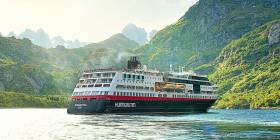Displaying items by tag: RCI
#CorkCityCallers – An expedition / coastal cruiseship that trades to both polar regions and a megayacht cruiseship called to Cork City quays this morning, writes Jehan Ashmore.
Norwegian operator Hurtigruten Voyages Midnatsol (midnight sun) which normally plies stunning deep-inland fjords headed up the River Lee to the city’s South Quay. The call to the city-centre is also where Le Soléal, a megayacht from Ponant Cruises docked at North Custom Quay. The 10,000 tonnes cruiseship flagged in the French territory of Wallis and Fortuna Islands, has 132 passenger suites.
It is relatively unusual to have such small cruiseships together in the city-centre, and both having sailed overnight from the same previous port of call. Afloat yesterday monitored the cruiseships at anchorage off Hugh Town, St. Mary’s of the Isles of Scilly.
What is the norm given increasingly larger giant cruiseships that call downriver to Cobh’s deepwater quay. An example been Royal Caribbean International 90,000 tonnes Serenade of the Seas which is arriving this morning from Ponta Delgada, Azores.
Midnatsol’s call to Cork is in advance of resuming the classic Hurtigruten coastal voyages along Norway’s rugged and spectacular coast. The voyage that dates to 1893, involves calling to 34 ports that depart Bergen daily in the south and reach as far north to Kirkenes close to border with Russia.
Prior to sailing to Scilly, Midnatsol had called to Brest, France and before that La Coruña, Spain. This particular cruiseship is part of Hurtigruten’s global ‘Explorer’ voyages that run outside the domestic duties along Norway, however she will rejoin fleetmates from May to September. Since last year, Midnatsol began running expedition cruises to Patagonia and Antarctica.
Of the 12-strong Hurtigruten fleet of passenger, freight and car-carrying vessels, Midnatsol (in which can handle 35 cars), belongs to the largest class of ships, the ‘Millennium’ series. The 16,000 gross tonnage Midnatsol completed in 2003 was built in the Nordic country in Rissa and likewise of her sisters can carry 1,000 passengers.
The sisters are Finnmarken and Trollfjord, the latter made a special promotional port of call to Dun Laoghaire Harbour. This took place early in the career of the ship that berthed at the East Pier from where a visit was made on board the vessel painted in the operator’s distinctive livery of red, black and white.
























































